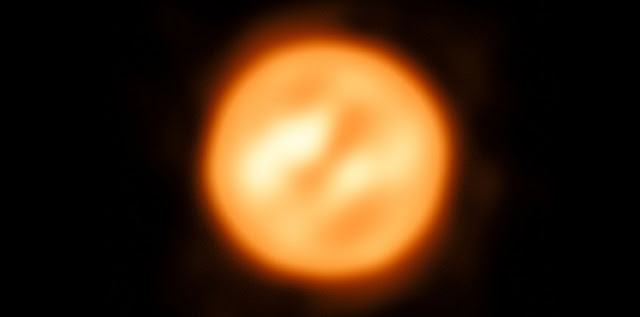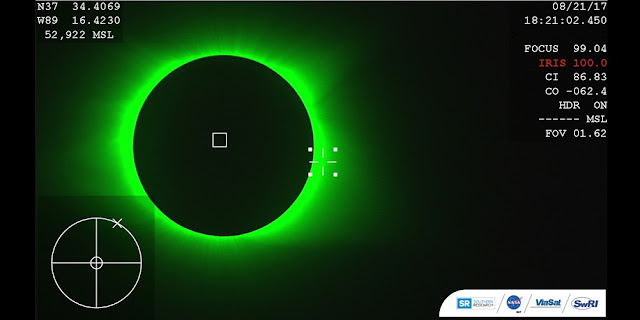Scientists Create ‘Diamond Rain’ That Forms in the Interior of Icy Giant Planets:
In an experiment designed to mimic the conditions deep inside the icy giant planets of our solar system, scientists were able to observe “diamond rain” for the first time as it formed in high-pressure conditions. Extremely high pressure squeezes hydrogen and carbon found in the interior of these planets to form solid diamonds that sink slowly down further into the interior.
The glittering precipitation has long been hypothesized to arise more than 5,000 miles below the surface of Uranus and Neptune, created from commonly found mixtures of just hydrogen and carbon. The interiors of these planets are similar—both contain solid cores surrounded by a dense slush of different ices. With the icy planets in our solar system, “ice” refers to hydrogen molecules connected to lighter elements, such as carbon, oxygen and/or nitrogen.
Researchers simulated the environment found inside these planets by creating shock waves in plastic with an intense optical laser at the
Matter in Extreme Conditions (MEC) instrument at SLAC National Accelerator Laboratory’s X-ray free-electron laser, the
Linac Coherent Light Source (LCLS). SLAC is one of 10 Department of Energy (DOE) Office of Science laboratories.
In the experiment, the scientists were able to see that nearly every carbon atom of the original plastic was incorporated into small diamond structures up to a few nanometers wide. On Uranus and Neptune, the study authors predict that diamonds would become much larger, maybe millions of carats in weight. Researchers also think it’s possible that over thousands of years, the diamonds slowly sink through the planets’ ice layers and assemble into a thick layer around the core.
“Previously, researchers could only assume that the diamonds had formed,” said Dominik Kraus, scientist at Helmholtz Zentrum Dresden-Rossendorf and lead author on the publication. “When I saw the results of this latest experiment, it was one of the best moments of my scientific career.”
Earlier experiments that attempted to recreate diamond rain in similar conditions were not able to capture measurements in real time, because we currently can create these extreme conditions under which tiny diamonds form only for very brief time in the laboratory. The high-energy optical lasers at MEC combined with LCLS’s X-ray pulses—which last just femtoseconds, or quadrillionths of a second—allowed the scientists to directly measure the chemical reaction.
Other prior experiments also saw hints of carbon forming graphite or diamond at lower pressures than the ones created in this experiment, but with other materials introduced and altering the reactions.
The results presented in this experiment is the first unambiguous observation of high-pressure diamond formation from mixtures and agrees with theoretical predictions about the conditions under which such precipitation can form and will provide scientists with better information to describe and classify other worlds.
In the experiment, plastic simulates compounds formed from methane—a molecule with just one carbon bound to four hydrogen atoms that causes the distinct blue cast of Neptune.
The team studied a plastic material, polystyrene, that is made from a mixture of hydrogen and carbon, key components of these planets’ overall chemical makeup.
In the intermediate layers of icy giant planets, methane forms hydrocarbon (hydrogen and carbon) chains that were long hypothesized to respond to high pressure and temperature in deeper layers and form diamond rain.
The researchers used high-powered optical laser to create pairs of shock waves in the plastic with the correct combination of temperature and pressure. The first shock is smaller and slower and overtaken by the stronger second shock. When the shock waves overlap, that’s the moment the pressure peaks and when most of the diamonds form, Kraus said.
During those moments, the team probed the reaction with pulses of X-rays from LCLS that last just 50 femtoseconds. This allowed them to see the small diamonds that form in fractions of a second with a technique called femtosecond X-ray diffraction. The X-ray snapshots provide information about the size of the diamonds and the details of the chemical reaction as it occurs.
“For this experiment, we had LCLS, the brightest X-ray source in the world,” said Siegfried Glenzer, professor of photon science at SLAC and a co-author of the paper. “You need these intense, fast pulses of X-rays to unambiguously see the structure of these diamonds, because they are only formed in the laboratory for such a very short time.”
When astronomers observe exoplanets outside our solar system, they are able to measure two primary traits—the mass, which is measured by the wobble of stars, and radius, observed from the shadow when the planet passes in front of a star. The relationship between the two is used to classify a planet and help determine whether it may be composed of heavier or lighter elements.
“With planets, the relationship between mass and radius can tell scientists quite a bit about the chemistry,” Kraus said. “And the chemistry that happens in the interior can provide additional information about some of the defining features of the planet.”
Information from studies like this one about how elements mix and clump together under pressure in the interior of a given planet can change the way scientists calculate the relationship between mass and radius, allowing scientists to better model and classify individual planets. The falling diamond rain also could be an additional source of energy, generating heat while sinking towards the core.
“We can’t go inside the planets and look at them, so these laboratory experiments complement satellite and telescope observations,” Kraus said.
The researchers also plan to apply the same methods to look at other processes that occur in the interiors of planets.
In addition to the insights they give into planetary science, nanodiamonds made on Earth could potentially be harvested for commercial purposes—uses that span medicine, scientific equipment and electronics. Currently, nanodiamonds are commercially produced from explosives; laser production may offer a cleaner and more easily controlled method.
Research that compresses matter, like this study, also helps scientists understand and improve fusion experiments where forms of hydrogen combine to form helium to generate vast amounts of energy. This is the process that fuels the sun and other stars but has yet to be realized in a controlled way for power plants on Earth.
In some fusion experiments, a fuel of two different forms of hydrogen is surrounded by a plastic layer that reaches conditions similar to the interior of planets during a short-lived compression stage. The LCLS experiment on plastic now suggests that chemistry may play an important role in this stage.
“Simulations don’t really capture what we’re observing in this field,” Glenzer said. “Our study and others provide evidence that matter clumping in these types of high-pressure conditions is a force to be reckoned with.”
The research collaboration includes scientists from Helmholtz Zentrum Dresden-Rossendorf in Germany, University of California-Berkeley, Lawrence Livermore National Laboratory, Lawrence Berkeley National Laboratory, GSI Helmholtz Center for Heavy Ion Research in Germany, Osaka University in Japan, Technical University of Darmstadt in Germany, European XFEL, University of Michigan, University of Warwick in the United Kingdom and SLAC.
The research was supported by DOE’s Office of Science and the National Nuclear Security Administration. LCLS is a DOE Office of Science User Facility.













